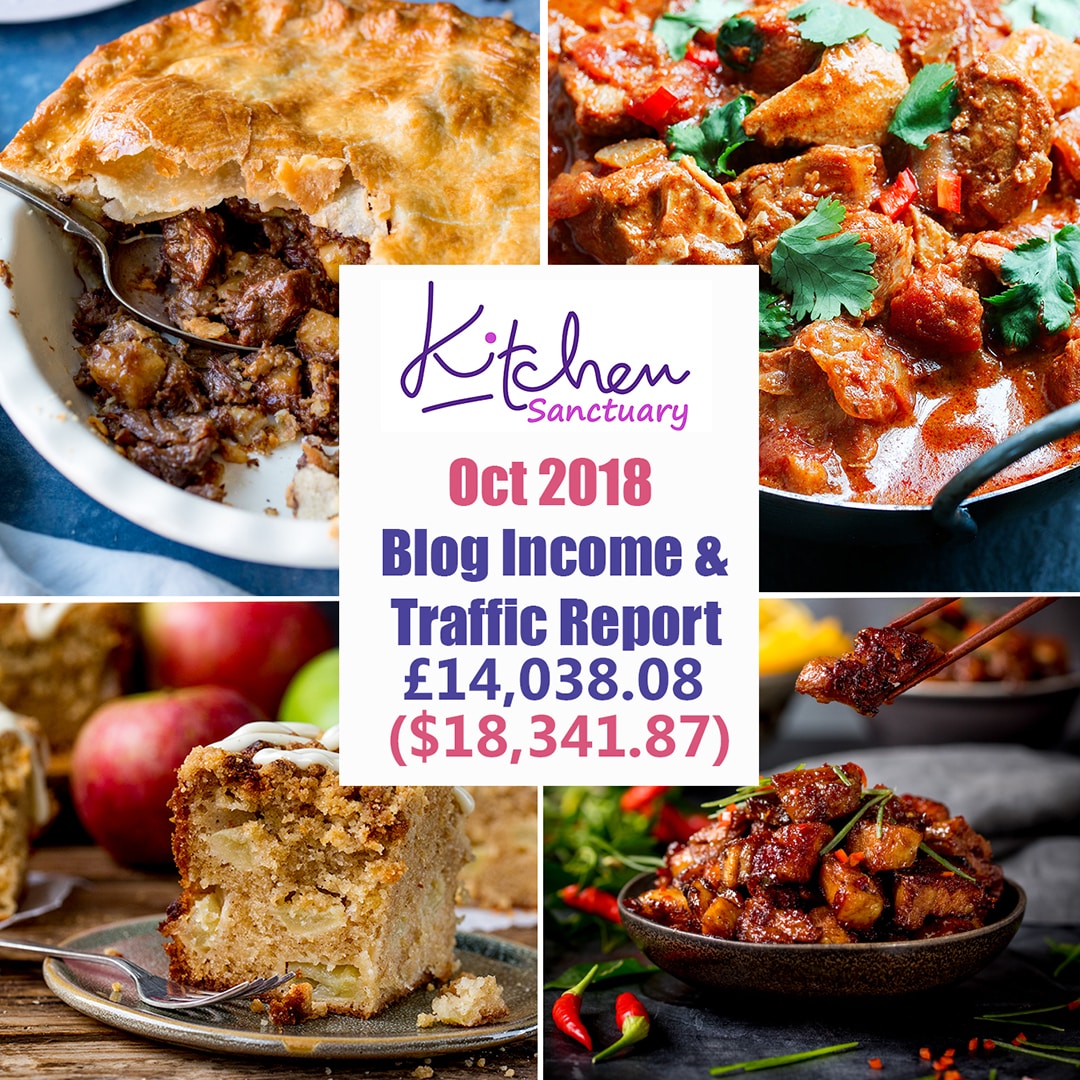
When I started looking into monetizing my blog, I seemed to fall into freelance writing pretty easily. It’s the brand work that took a lot of time to start to build up.
For a long time, I had it in my head that I should try to cut down on the freelance recipe work and increase the brand work. However, after talking to quite a few other bloggers who do more brand work than freelance, they tend to feel the opposite is preferable.
After all, freelance work is often regular work with consistent pay – unlike the brand work which often takes time and effort to pitch, discuss, negotiate, complete, sometimes rework, and then invoice for each individual article or blog post.
(Btw, I define freelance work as work that I do outside of my site – whether it’s for another website (such as a lifestyle blog, or brand website) or a magazine. Whereas brand work or ‘sponsored work’ is where I’m using my blog and social accounts (and therefore my influencer potential) to promote that brand or a product produced by that brand.)
There are lots of arguments for and against freelance work when you’re trying to build up your blog as a business, but freelancing is something I’d definitely recommend if you’re trying to take that step in making your blog your full-time job.
How did I get into freelancing?
My first freelancing ‘job’ was about 10 months after I started blogging. I say ‘job’, but in fact I wasn’t getting paid towrite for this particular site. I’d emailed a request to join a Pinterest group board, and the owner liked my blog, and asked if I’d be interested in contributing to her site. I jumped at the opportunity! This involved me writing a monthly recipe post, including photography and social promotion of the the post after writing it.
Sounds like a lot of work when you’re not getting paid, but it was something I felt I needed to do, to give me some experience working for other blogs. I tutted at the list of guidelines, and moaned a bit (only to myself, NEVER to the client) if extra requests or changes were required, but it really did give me a good understanding of how the bigger blogs that use contributors work. Plus, I was allowed to re-post the recipes on my own site 30 days after they went live on the original site, so I had some ready-made content for Kitchen Sanctuary on those days when I was short on time.
Since then, I’ve become a regular contributor on a number of websites, and a couple of print magazines, and although I do less freelance recipe work now, it’s still something I enjoy.

What worked for me:
Opportunities for freelance work can arise from various sources. Here are some examples of what has worked for me:
- Once you have some experience with blog post writing, you can approach some other bigger blogs – ask them if they’d like a recipe creating for their site. I did this for a few sites for free to get some experience. Sometimes, if they really like that first post, they’ll offer to pay you for more. Often this is a low amount – like $50 a post – but it’s a start. In fact I was writing $50 recipe posts (including photographs) up until only a year ago.
- At some point (for me it was when I had maybe 50 or 60 posts on the blog) I noticed I was being included in some round-up posts for bigger sites. In some cases I reached out to them – since it already showed that they liked my work by including them in their round-up. I asked if they had any openings for paid contributors. Mostly it was no, but sometimes yes.
- See who’s liking a lot of your posts on social media – perhaps they’re a bigger blogger who you could approach to see if they’d accept contributors. This is one that worked for me – I wrote the first post for free, then ended up writing 2 posts a month for them for over a year.
- Use your bargaining power – if you’ve managed to get any freelance work and you know the website/publication is looking for more freelancers, reach out to other blogger buddies who you think might be freelancing, and see if you can recommend each other to your respective publishers.
- Google terms like ‘accepting contributors’, ‘guest post’, ‘blog contributor’ to see if you can find sites that take on freelancers.
- If you’re part of a blogger group (i.e a facebook group) and it’s within the group rules, start a list of people who are looking for freelance work. Include information like name, blog url and writing niche. Then get your name at the top of that list. If anyone from that group knows of people looking for freelancers (or if you are contacted by someone who’s looking for a freelance writer, but it’s out of your niche) that list is a great resource to recommend each other.
Other sources:
There are other ways to look for freelance work too, for example:
- Job boards (such as pro blogger)
- Putting yourself out there on social media – ask on Facebook/Twitter etc if anyone knows of freelance writing opportunities
- Freelancing writing websites/agencies (such as Upwork)
I haven’t tried the first two in this list, but I did try Upwork when I first started blogging (I didn’t get any work out of it though).
How to pitch for freelance work:
The most important thing to remember is that your blog and any previous sponsored/brand or freelance work are all elements of your résumé. Try to ensure the writing and photography on your site are the best they possibly can be.
As a food blogger, you have experience not only in writing, but also in recipe creation, food photography, food styling, photo editing, reader engagement, social media promotion and content platforms (i.e WordPress). That’s a big bunch of skills!
A lot of companies employ different people for each of those skills.
Work on those skills as much as possible, keep improving, sell yourself and you will find freelance work.
Here are a couple of examples of how I pitch. One focuses on examples of previous work, the other focuses on post suggestions and reader insights. You can of course combine both approaches if you wish:
Example 1 (previous work): ✉✉
Hi [insert name if known],
My name is Nicky and I’m a food blogger based in the UK.
I write at http://kitchensanctuary.com – which is a family-friendly recipe website with delicious recipes and photographs.
I wondered if you’re accepting article submissions at the moment?
Quite a few of my recipes have been featured on [your site/website name], and I’m always drawn in to all of the other sections of your beautiful site when I come and visit.
I’ve attached some examples of other freelance work and popular recipes on my blog to give you an idea of my work:
Example 1 url
Example 2 url
Example 3 url
Please let me know if you’d like to discuss further.
Thanks,
Nicky
Example 2: ✉✉
Hi [insert name if known],
I’m Nicky from http://kitchensanctuary.com.
First of all I wanted to say thank you for including my [insert recipe name] in one of your roundups, and also for liking my pictures on [insert social media site].
I was wondering if you have any space for contributors at the moment?
I would love to create some recipe articles for your blog.
Some of my ideas include:
Recipe idea 1 and why (popular during winter)
Recipe idea 2 and why (popular with my readers)
Recipe idea 3 and why (I notice you get a lot of engagement on these types of posts)
Please let me know what you think, and thanks for your time.
Nicky
What about money? 💰💰
Personally, I don’t talk money in my initial email.
If I’ve decided that I’m happy to do a post for free, then I won’t mention money until after that first post has gone live. This gives the editor or website owner a chance to see if they like your work, and whether their audience responds positively.
If I’m looking for paid work from the outset, I would bring it up only when I’ve received a positive response from my pitch.
I still hate this part of the job, but it’s got to be done if you want to turn this blogging thing into a full time job!
You can pretty much guarantee that they won’t mention money in their response, so it’s up to you to broach the subject.
I would say something like:
‘Great! I’d love to work with you.
Please can I check – do you have a budget for contributor articles? My normal rate is [insert rate], but I’d be happy to discuss.’
That way you can open the conversation and negotiate.
Some things to consider:
- Whether they want more than one post (or even an ongoing relationship)
- If they want a trial – offer a free post first, but agree what the future post rate is if they like your work
- Whether they want to own the material you produce (if you’re allowing them to have full copyright to do what they want with your work, and you’re not allowed to use it for your own purposes, you need to charge more!!)
- If you can include a link to your site in the post you write
- Whether they’re happy for you to post the recipe on your own site after a certain time period (e.g. 30 days) – this is useful so you have some ready-made content for your own site, but it’s likely that the site you’re writing for will rank higher on google search.
But I’m nervous! 😧😧
I used to be a bit of a scaredy cat when it came to seeking opportunities, but I’ve overcome that (mostly!) with a few things I often tell myself:
- Take a bit of a risk – not quite sure if you’re good enough? Do it anyway.
- Not sure how to do something? Research it – google it, you tube it. If you think you’ll be able to figure it out, then yes, you can do it.
- It’s better to come across as confidant and knowledgeable than nervous and unsure
I hope that’s been helpful!
Please let us know what’s worked for you, of if any of these tips have helped you find freelance work.
I’d love to hear your stories!








Thank you so much Nicky for this incredibly useful post. Freelancing feels like such a tricky thing to get into. This post makes it seems straightforward and achievable. Hoping so anyway! Thank you!
Great information. I had a few successes mainly hit and miss. This helps a lot!
Really glad to hear that it was useful Veronica 🙂
Thanks
Chris & Nicky
Your post information is very unique and useful for all readers.
This is great information.This post is very useful.Thanks lot
.https://www.freelancer-shahid.com
Excellent pieces. Keep writing such kind of
information on your site. Im really impressed by your blog.and
you write about freelance writer. I job as a writer and
blogger. I enjoy creating numerous overview articles
and essays. You can finhd my operates here: there (Kathrin).I really hope it will
help a person as well.|
Hey there, You’ve done an excellent job. I’ll certainly digg it and in my view suggest to my friends.
I am confident they wilol be benefited frim this website.I work
aas a writer and blog writer. I love writing numerous overview essays and articles.
You can get my works right here: https://www.Piesync.com/blog/4-easy-steps-to-improve-your-email-marketing-strategy/.I aam
hoping this caan help somebody too.
Hi Nicky!
Let me start saying that I read this article like 4 to 5 times this month. I’ve been struggling to put myself out there and this article gives me a great boost of energy.
By chance, do you have any sort of list with online sites that are currently accepting food writers as contributors? I’ve been googling it but I can’t seem to find an opportunity.
Thanks A LOT for this type of post. I know is an old post from 2017, but it is still useful for me.
Hi Maria,
I’m so glad the post is giving you some inspiration 😊
I don’t have a list of freelance sites – as I only do limited freelance work currently.
However, recently I’ve found the best way is to search on Facebook for ‘Contributors’ and select the option for “search in your groups and pages”.
If you’re part of any blogging groups (and if you’re not, try to join some!) you should see any recent requests fro contributors.
Also, have a search for VA groups on facebook. If you can join a few, people sometimes sell their services/posts or photos on there. There may be one where you can offer your services.